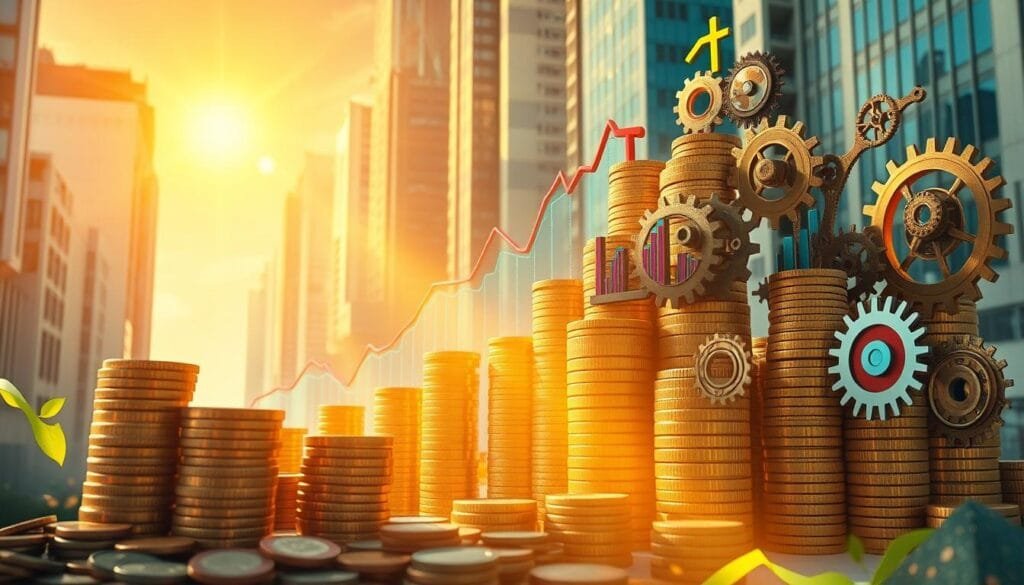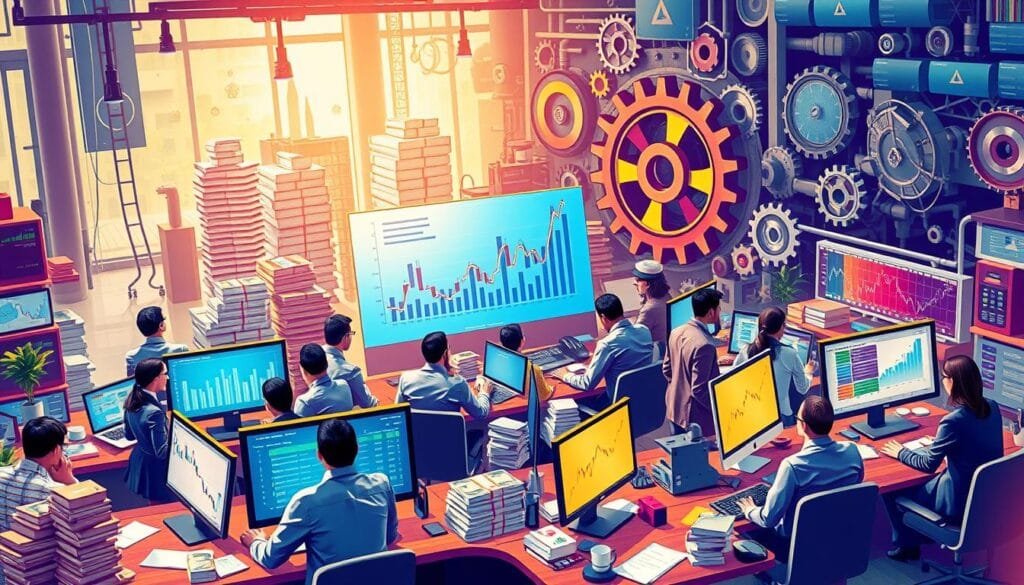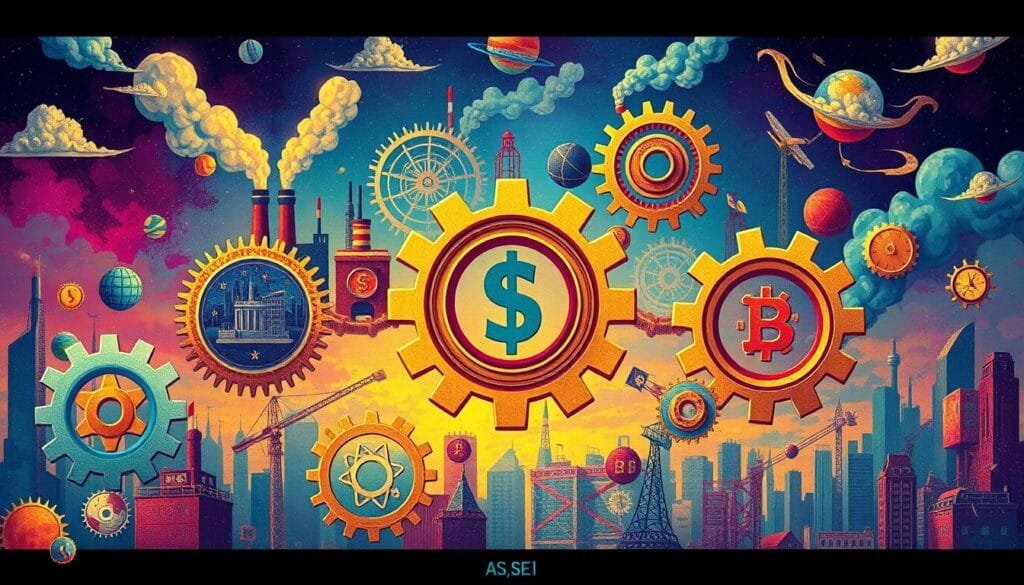What drives wealth in our economy? Is it just money, or is there more to it?
Economic capital is not just money. It includes resources like equipment and intellectual property. These resources play a key role in creating value and boosting wealth.
Capital shapes how resources are used in businesses, families, and economies. It’s not just cash but also physical machinery and financial tools. They are crucial for economic growth and for how companies operate.
Key Takeaways
- Capital is one of the four fundamental factors of production, alongside land, labor, and entrepreneurship.
- Economic capital is distinct from financial capital, focusing more on production-related assets.
- Enhancing capital equipment leads to increased productivity and a higher standard of living.
- Capital structures, often a mix of debt and equity, reflect a company’s strategic financing approach.
- Capital goods are essential to the production process, generating value and wealth creation.
- Investment strategies and capital management are crucial for business growth and expansion.
- The control over production factors varies widely between capitalist and socialist economies.
Introduction to Capital in Economics
Understanding capital is key in analyzing business and economic functions. Capital comes in different forms like financial, physical, or intellectual. It’s vital for productivity and growth.
Definition of Capital
Capital includes assets that create economic value. This includes financial assets, physical machinery, and intellectual property. These assets help in operations, making goods and services, and growth. Adam Smith saw capital as stock that brings revenue.
Role of Capital in Business and Economy
The mix of debt, equity, and working capital in a business influences its efficiency and growth. In 2020, U.S. companies increased their corporate bonds by 70%. This shows reliance on debt to keep businesses running. Moreover, bond yields dropped to a multi-year low of about 2.3%, showing favorable loan conditions.
Analyzing a business’s capital structure involves looking at its debt and equity mix and how this affects spending and investments. How easily a company can use capital influences job creation, industrial growth, and global stability.
On a larger scale, a nation’s capital stock includes things like buildings and equipment. These capital goods, or CoPS, are key for analyzing growth and income distribution. Their life cycle includes tendering, making, and maintenance, important for innovation.
Having capital goods is crucial because they help produce other goods. This is different from consumer goods that are used directly. For industries needing costly equipment, capital goods can make it hard for new companies to start. This shows how important proper capital management is.
Types of Capital in Economics
In the world of business, different kinds of capital help companies grow and thrive. Each type has a special role in boosting growth, ensuring cash flow, and supporting investments. Knowing these types is key for good financial management and planning.
Debt Capital
Debt capital is all about borrowed money that needs to be paid back with interest. Loans and bonds are common sources. Using debt capital, companies can embark on big growth projects without giving up any ownership. Yet, it’s vital to keep things balanced. High leverage might lead to big profits, but it also raises the risk of running into financial trouble.
Equity Capital
Equity capital comes from investors who put money into a business for a share of ownership. It’s crucial for firms looking to grow or start new ventures without adding debt. Investors get to share in the profits but also face the risk of losses. This makes equity a key part of a company’s finances. Analysts use measures like profit margins and ROE to judge performance.
Working Capital
Working capital is the money needed for everyday business operations. It’s found by subtracting current liabilities from current assets. Managing it well is crucial so a company can cover its short-term debts. Firms often turn to short-term solutions like bank overdrafts and trade credit for their working capital needs.
Trading Capital
Trading capital is set aside for dealing in securities, mainly by trading firms and brokers. Success in trading demands smart capital use and risk strategies to boost returns. Valuing securities involves methods that depend on market views and economic conditions, like book value and expected return.
Making wise decisions about debt capital, equity investments, and managing working capital is crucial for businesses. Each capital type brings its benefits and challenges, vital for growth and financial stability.
What is Capital in Economics?
In economics, capital means all the financial resources, machines, and other tools that help produce more goods and services. It includes money, property, and intellectual stuff. Knowing about economic capital helps understand how businesses grow and work better.

Physical capital and human capital are the main types of capital. Physical capital is stuff you can touch, like machines and buildings, which help make products. These items play a big part in keeping businesses running and can be a challenge for new companies to get, especially in making things.
Machinery in factories making things like shoes is an example of physical capital in action. Human capital, though, is about the skills and knowledge of people. It’s vital for using physical capital well. This shows why managing both kinds of capital well matters a lot in business.
Fixed capital is another part of physical capital, including things like factory equipment that you can use many times. But, such capital loses value over time. Investments in fixed capital might take a long time to show their costs on business books. This affects a company’s financial state over years. For example, as factory machines get older, they’re not as good, so companies need to update them.
The Organisation for Economic Co-operation and Development (OECD) says measuring physical capital needs clear rules. They look at goods that last over a year, things you can touch, and assets used many times. They don’t count things you can’t touch or natural things. This way, both businesses and economists can know the value of their capital better.
| Category | Inclusion Criteria | Examples |
|---|---|---|
| Durable Goods | Lasting longer than one year | Machinery, Vehicles |
| Tangible Goods | Physical items excluding intangibles | Buildings, Equipment |
| Fixed Assets | Reusable items not consumed in production | Manufacturing Equipment |
It’s important for businesses to understand different capital types, like fixed and circulating capital. This helps them put their financial resources and other assets to good use. Knowing all about economic capital lets businesses do better and helps the economy grow.
How Capital is Utilized in Business
Capital is key in today’s fast-paced business world. It helps businesses grow and stay ahead. By using funds wisely, companies can innovate and reach new markets.

Investment Strategies
Creating smart investment plans is crucial. These plans allow businesses to put money into areas with great returns. Investing in tech, new products, or expanding can greatly boost a company’s success.
Companies focus on financial growth to see how investments pay off. Successful ones often see returns of over 15%.
Capital Management
Managing finances well is key to a company’s stability. It helps meet short- and long-term needs. Good management prevents running out of cash, so the business keeps running smoothly.
A balance between assets and debts is important. Figuring out the working capital ratio shows if a company is healthy. Smart management can boost cash flow by 20%-30%, making operations more flexible.
Growth and Expansion
Good use of capital means more growth and reaching further. Companies might spend on new places or equipment to keep up with demand. Such investments create jobs and help the economy.
Choosing the right mix of debt and equity lowers costs. This can reduce costs by up to 10%. It leads to better investment choices, keeping companies competitive and profitable in the long run.
Knowing how to use capital well is crucial in today’s business world. From wise investments to growth, companies need to manage their money well. This is how they succeed and keep growing.
The Economic Role of Capital
The importance of capital in the economy cannot be overstated. It drives economic growth, boosts productivity, and improves living standards. By investing in capital goods like tech and machinery, it increases economic output and efficiency. The capital function also includes strategic investment and allocating resources. This leads to innovation, development, and overall economic stability.

The growth story of the United States highlights how crucial capital formation is. From 1869 to 1993, the real GDP grew by about 3.3% each year. This led to a significant increase in goods and services over 125 years. During this period, the U.S. population grew by 1.5% annually.
As a result, per capita real GDP went up by roughly 1.8% every year. By the 1990s, each person had access to eight times more goods and services than in the 1870s.
Growth rates significantly affect economic performance. Starting with a real GDP per capita of $26,933.32 at the end of Q3 1995, a 2% growth rate after 5 years leads to nearly 5% higher GDP per capita than a 1% growth rate. Over 25 years, the 2% growth rate results in a 25% higher real GDP per capita compared to a 1% growth rate.
From 1970 to 1995, the U.S. real GDP saw big ups and downs due to recessions and recoveries. After the recessions in the early 1970s and early 1980s, there were long recovery phases. Increased labor supply usually leads to higher real GDP. Durable physical capital, like computers and factories, is essential for keeping production going.
Investing in both people and physical assets has a big impact on future capital and growth rates. This shows how capital is key for enhancing productivity and ensuring economic growth. In 2020, U.S. companies issued 70% more corporate bonds than in 2019. This highlights how financial tools help with capital formation and keeping liquidity.
Having enough working capital is crucial for businesses to pay off short-term debts and manage cash flow. Working capital is calculated as current assets minus current liabilities. Good management of working capital helps companies avoid running out of cash. This supports smooth operations and economic stability.
Recent trends in capital formation include significant equity capital raised through IPOs in 2021 by companies like Zomato, Paytm, and Nykaa. These actions show the ongoing importance of strategic investment and resource allocation. It underscores their role in spurring economic growth and enhancing productivity.
Conclusion
Capital in economics is key to business plans and the economy’s shape. It helps fund operations and large projects. Understanding types like debt, equity, and working capital is a must. Knowing how to use them well aids in economic decisions.
Our look at capital resources shows the importance of managing it smartly. Good strategies increase productivity, help businesses grow, and keep the economy stable. For more info on capital resources, check out this resource.
The gap in wealth is a big economic issue, too. The richest 1 percent’s wealth is outpacing overall growth, widening economic differences. This wealth gap increases their political power, making inequality worse.
For the Baltic states, knowing about capital trends matters a lot. Foreign ownership has helped their banks stabilize. Lease financing is becoming more popular. With new regulations, expect more investments, especially in Estonia. This knowledge helps us handle economic ups and downs.
FAQ
What is the definition of capital in economics?
Capital in economics refers to assets that can create value for their owner. These include things like money, equipment, and intellectual property. They help in making goods and services, leading to wealth creation.
What role does capital play in business and economic growth?
Capital is essential for businesses to function and grow. It provides the resources needed to buy and maintain machinery and technology. This, in turn, boosts productivity and economic output.
What are the different types of capital in economics?
There are several types of capital, such as debt and equity capital, alongside working and trading capital. Debt capital must be paid back. Equity capital comes from owning a piece of a business. Working capital is for everyday expenses, and trading capital is for buying and selling stocks.
How can businesses acquire capital?
Businesses can get capital by taking on debt or giving out shares. Debt means borrowing money that has to be repaid. Equity means selling part of the business to investors. For trading securities, trading capital is used.
What is the significance of capital in economic productivity and growth?
Capital is key for business efficiency and growth. It gives companies the tools and money they need to do well and grow. Investing wisely in capital goods helps economy to grow and innovate.
How do effective investment strategies contribute to capital utilization?
Good investment strategies help in putting money into projects with the best returns. This boosts a firm’s success and its financial stability. It leads to growth and better value for the economy.
What is working capital and why is it important?
Working capital is what a company has on hand for daily costs. It’s found by subtracting what you owe soon from what you have. Having enough working capital is crucial for covering day-to-day needs and staying efficient.
How does the accessibility of capital influence the economic landscape?
Easy access to capital shapes the economy by boosting jobs, industrial growth, and stability worldwide. It allows for more investment and productivity, enhancing the overall economic health.
